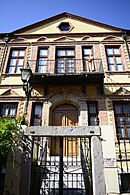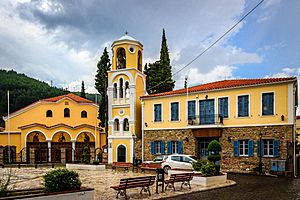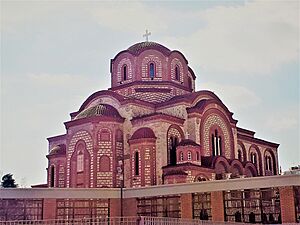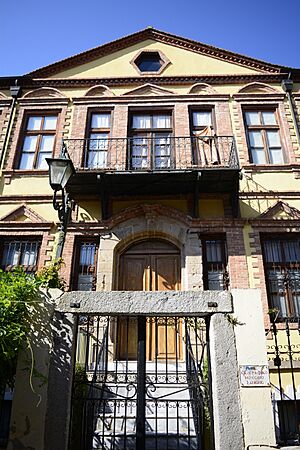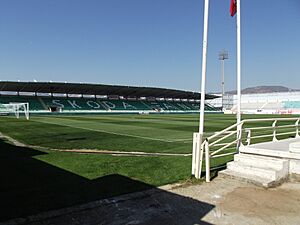Xanthi facts for kids
Quick facts for kids
Xanthi
Ξάνθη (Greek)
|
|
|---|---|
|
From top left: aerial view of the city, Xanthi old town, Cathedral of St. Sophia The Wisdom of God, folk and history museum, Xanthi clocktower, Central square, a church in the old town.
|
|
| Country | Greece |
| Geographic region | Thrace |
| Administrative region | Eastern Macedonia and Thrace |
| Regional unit | Xanthi |
| Area | |
| • Municipality | 495.1 km2 (191.2 sq mi) |
| • Municipal unit | 153.1 km2 (59.1 sq mi) |
| Elevation | 82 m (269 ft) |
| Population
(2021)
|
|
| • Municipality | 66,875 |
| • Municipality density | 135.074/km2 (349.84/sq mi) |
| • Municipal unit | 65,240 |
| • Municipal unit density | 426.13/km2 (1,103.7/sq mi) |
| Community | |
| • Population | 58,760 (2021) |
| Time zone | UTC+2 (EET) |
| • Summer (DST) | UTC+3 (EEST) |
| Postal code |
67100, 67131, 67132, 67132
|
| Area code(s) | 2541 |
| Vehicle registration | AH |
| Website | www.cityofxanthi.gr |
Xanthi (pronounced KSAN-thee) is a city in northeastern Greece. It is located in a region called Western Thrace. Xanthi is the main city of the Xanthi area. It is part of the larger East Macedonia and Thrace region.
The city is built on the slopes of the Rhodope mountains. The Kosynthos River divides Xanthi into two parts. The western side has the old and new towns. The eastern side has beautiful nature.
Xanthi's "Old Town" is famous in Greece. It has unique buildings that mix old Byzantine Greek churches with grand homes. These homes belonged to Greek merchants from the 1700s and 1800s. You can also see mosques from the Ottoman period. Other cool places to visit include the Archaeological Museum of Abdera and the Greek Folk Art Museum.
Xanthi is also well-known for its yearly spring carnival. This big event helps the city's economy. Over 40 cultural groups from all over Greece join in the carnival fun. There are concerts, plays, music and dance nights, and exhibitions. People also enjoy cycling events, street games, and acting out old customs.
Contents
What's in a Name?
There are two ideas about how Xanthi got its name. One idea is that it was named after a daughter of two Greek gods, Oceanus and Tethys. Another idea says it was named after Xanthi, one of the Amazons. The Amazons were legendary female warriors who supposedly ruled this area.
Xanthi is called İskeçe in Turkish. In Bulgarian, it is known as Скеча (Skecha) or Ксанти (Ksanti).
A Look Back in Time
Some people think Xanthi might be the ancient city of Xantheia. This city was mentioned by a geographer named Strabo around 100 BC. However, no other ancient historians talked about it. Xanthi started as a small village. It went through many tough times, like invasions, disasters, and wars.
By the 3rd century AD, most people had left the Xanthi area. Almost everything was destroyed. When the Ottomans took over in 1361, they brought Turkish settlers. This led to the creation of new towns. But Xanthi and Oraio mostly remained Greek and Christian centers.
Xanthi in the Middle Ages
Xanthi was a strong and wealthy city during the Byzantine Empire. Later, it became a colony of the Ottomans. It was then known as Eskije. The first time Xanthi was officially written about was in 879. A bishop from Xantheia was at an important church meeting.
From the 1200s to the 1300s, Xanthi was the most important city in its region. Three old monasteries still exist from this time. These are Pammegiston, Taxiarchon, and Panagia Archangeliotisa. Xanthi was also part of a military campaign in 1327.
Early Modern Times
By 1715, Xanthi became famous for its high-quality tobacco. Many visitors from other countries came to see the area. They wrote about the lives of the local people. The tobacco trade across Europe brought a lot of wealth to Xanthi.
In 1829, two earthquakes destroyed the city. But this actually helped Xanthi. The city was rebuilt right away. In 1870, a nearby city called Genisea burned down. So, all its businesses moved to Xanthi. At that time, Xanthi had about 10,000 people.
A railway line was built near the city in 1891. This helped the economy grow even more. New schools and groups were started. Before 1912, Xanthi was part of the Ottoman Empire.
Balkan Wars and World War I
During the First Balkan War, the Bulgarian army took Xanthi from the Ottomans in November 1912. In the Second Balkan War, the Greek army captured it in July 1913. But a peace agreement, the Treaty of Bucharest, gave Xanthi to Bulgaria. It stayed part of Bulgaria until the end of World War I.
After Bulgaria lost the war, Xanthi was managed by the Allied forces. On October 4, 1919, the Greek army entered the city. This day is now celebrated in Xanthi as its liberation anniversary. A local hero, Gavriel Ladas, led the first Greek troops into the city. He later became the mayor of Xanthi.
World War II and After
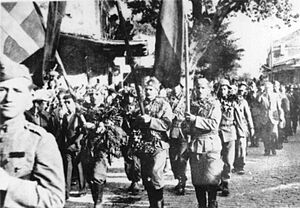
In April 1941, during the German invasion of Greece, German forces captured Xanthi. They then gave the city to Bulgaria. Bulgaria occupied the entire region east of the Strymonas River. During this time, more than 2,000 people from Xanthi, both Christians and Muslims, were made to work without pay in Bulgaria.
In March 1943, the Jewish people of Xanthi were arrested by the Bulgarians. They were held in a tobacco warehouse. Then, they were sent away to very difficult camps in Poland. Out of 550 Jewish people, only six survived. The synagogue, a Jewish place of worship built in 1926, was later used by other groups and then torn down in 1995.
Xanthi was freed after a change in government in Bulgaria. Greek fighters entered the city and took control without a fight. The Bulgarian army left the area by the end of October 1944.
Xanthi Today
Today, Xanthi is a modern city with a rich past. It has many traditions and customs. It also has many interesting places for visitors. Xanthi is known as the city of a thousand colours. Like other nearby cities, it has a large population of Turkish-speaking Muslims. These Muslim people have lived in the area since the Ottoman period. They were allowed to stay in Greece after a population exchange in the 1920s.
In 1972, Greek officials planned to tear down the city's famous clock tower. This tower was built in 1870. Local Muslims protested this decision, and the plans were stopped.
Getting Around
Road Travel
The Egnatia Motorway passes near Xanthi. This highway connects Xanthi with other parts of Macedonia, Epirus, and Thrace. The Xanthi Bus Station has daily buses to many cities in Greece.
Xanthi is about 206 km from Thessaloniki and 704 km from Athens. It is also 397 km from Istanbul and 236 km from Edirne. A new border crossing point opened in 2010. It connects Xanthi with Bulgaria, making travel easier.
Train Travel
The Xanthi railway station is outside the city. It is on the Thessaloniki-Alexandroupoli line. There are daily train services to Thessaloniki and Alexandroupolis.
Air Travel
Xanthi does not have its own airport. Most people use Kavala Airport, which is 42 km away. Alexandroupolis Airport, 112 km away, is also an option.
City Government
The municipality of Xanthi was created in 2011. This happened when two smaller areas, Stavroupoli and Xanthi, joined together. The total area of the municipality is about 495 square kilometers.
Local Areas
The Xanthi municipal unit is divided into smaller communities. These are Evmoiro, Kimmeria, and Xanthi itself. These communities include several villages and settlements.
Economy and Jobs
Historically, people in Xanthi worked in the tobacco business, trade, and farming. In recent years, tourism has grown a lot. Many visitors come during the "Old Town Festival."
Population Growth
| Year | Population |
|---|---|
| 1940 | 31,015 |
| 1951 | 27,283 |
| 1961 | 27,802 |
| 1971 | 27,040 |
| 1981 | 33,897 |
| 1991 | 38,808 |
| 2001 | 46,464 |
| 2011 | 56,151 |
| 2021 | 58,760 |
Learning and Education
Xanthi is home to the School of Engineering at Democritus University of Thrace. This university has several departments:
- Department of Electrical and Computer Engineering
- Department of Civil Engineering
- Department of Environmental Engineering
- Department of Architectural Engineering
- Department of Production Management Engineering
Fun Cultural Events
Carnival and Old Town Festivals
Xanthi is a city rich in history, traditions, and customs. It is known as a cultural hub and a "city of a thousand colours." The Xanthi Carnival in February is very popular. It is one of the biggest carnivals in Greece. The "old town festival" in early September is also very famous.
Every Saturday, there is a well-known bazaar (market) at Emboriou Square. The Manos Hatzidakis' festival also brings people from all over the world.
Museums to Explore
Xanthi has several interesting museums:
- Folklore and Historical Museum of Xanthi
- Ecclesiastical Museum Metropolis of Xanthi (church museum)
- Municipal Gallery of Xanthi (art gallery)
- Museum of Natural History
- Foundation of Thracian Art and Tradition
- Museum of the History of the Greek Costume
- Manos Hadjidakis House (dedicated to the famous composer)
Sports Teams
Xanthi has several sports teams:
- Xanthi FC: A football (soccer) team that plays in the Super League Greece 2.
- Xanthi BC: A basketball team that played in the Greek A2 League.
- Aspida Xanthi: A club with football and basketball teams.
- Orfeas Xanthi FC: Another football team.
- Orion Xanthi: A basketball team.
Famous People from Xanthi
Many notable people come from Xanthi:
- Manos Hadjidakis (1925–1994): A major Greek composer. He won an Academy Award for his song "Never on Sunday."
- Şerif Gören: A Turkish film director who won a top award at the Cannes Film Festival.
- Archbishop Christodoulos (1939–2008): A former leader of the Greek Orthodox Church.
- Vasilis Torosidis: A football player for Olympiacos F.C. and the Greece national football team.
- Zafeiris Melas: A popular Greek singer.
- Apostolos Roumoglou: A basketball player for the UConn Huskies in the USA.
City Partnerships
Xanthi has "twin city" relationships with other cities around the world. This helps build friendships and cultural exchange.
 Smolyan, Bulgaria
Smolyan, Bulgaria Novi Beograd, Serbia
Novi Beograd, Serbia Gifhorn, Germany
Gifhorn, Germany Biga, Turkey (since 2000)
Biga, Turkey (since 2000) Bursa, Turkey
Bursa, Turkey Adra, Spain
Adra, Spain
Images for kids
See also
 In Spanish: Xánthi para niños
In Spanish: Xánthi para niños





